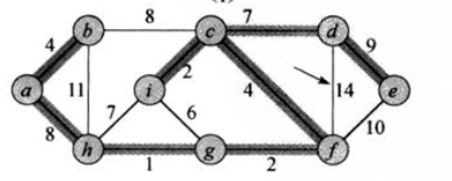1.图的最小生成树(贪心算法)
我两个算法的输出都是数组表示的,当前的索引值和当前索引对应的数据就是通路,比如parent[2] = 5;即2和5之间有一个通路,第二个可能比较好理解,第一个有点混乱
是什么?
将一个有权图中的 所有顶点都连接起来,并保证连接的边的 总权重最小,即最小生成树,最小生成树不唯一
为什么?
传入邻接矩阵,返回可以生成最小生成树的数据
我们有两种方式生成图的最小生成树1.普里姆(Prim)算法2.克鲁斯卡尔(Kruskal)算法
怎样做?
下面是普里姆算法的最小生成树

下面是克鲁斯卡尔算法的最小生成树:

图的邻接矩阵表示法(无向图,上三角矩阵)
int[][] arr = new int[][]{
{-1, 4, 0, 0, 0, 0, 0, 8, 0},
{0, -1, 8, 0, 0, 0, 0, 11, 0},
{0, 0, -1, 7, 0, 4, 0, 0, 2},
{0, 0, 0, -1, 9, 14, 0, 0, 0},
{0, 0, 0, 0, -1, 10, 0, 0, 0},
{0, 0, 0, 0, 0, -1, 2, 0, 0},
{0, 0, 0, 0, 0, 0, -1, 1, 6},
{0, 0, 0, 0, 0, 0, 0, -1, 7},
{0, 0, 0, 0, 0, 0, 0, 0, -1}
};
1.普里姆算法(加点法)
需求:求出最小生成树的权值
输入参数:二维数组arr(邻接矩阵),列表list(存放已经被加入的点),整型sum(存放权值)
输出参数:整型数组parent
1)先找一个起点,这个起点为任意一点,放入list中2)如果list中不包含全部节点,进入循环1>遍历list中节点,查找不存在list中的邻接节点的最小值,记录下begin和end2>将begin和end放入数组中,较小值节点赋值给较大值所在数组位置
3)返回parent
实现:
importjava.util.ArrayList;importjava.util.Arrays;importjava.util.List;/*** 普里姆(Prim)算法
*
*@authorXiong YuSong
* 2019/3/22 16:02*/
public classPrim {public static voidmain(String[] args) {int[][] arr = new int[][]{
{-1, 4, 0, 0, 0, 0, 0, 8, 0},
{0, -1, 8, 0, 0, 0, 0, 11, 0},
{0, 0, -1, 7, 0, 4, 0, 0, 2},
{0, 0, 0, -1, 9, 14, 0, 0, 0},
{0, 0, 0, 0, -1, 10, 0, 0, 0},
{0, 0, 0, 0, 0, -1, 2, 0, 0},
{0, 0, 0, 0, 0, 0, -1, 1, 6},
{0, 0, 0, 0, 0, 0, 0, -1, 7},
{0, 0, 0, 0, 0, 0, 0, 0, -1}
};
List list = new ArrayList<>();//先将0放置在list中
list.add(0);int begin = 0, end = 0, weight;int[] parent = new int[arr.length];for (int i = 0; i < arr.length; i++) {
parent[i]= -1;
}while (list.size()
weight=Integer.MAX_VALUE;for(Integer row : list) {for (int i = 0; i < arr.length; i++) {if (!list.contains(i)) {if (i >= row + 1) {if (arr[row][i] > 0 && arr[row][i]
begin=row;
end=i;
weight=arr[row][i];
}
}else if (i <= row - 1) {//我这里只用了上三角矩阵,所以这里需要画蛇添足写这一部分
if (arr[i][row] > 0 && arr[i][row]
begin=row;
end=i;
weight=arr[i][row];
}
}
}
}
}
list.add(end);
parent[end]=begin;
}
System.out.println(Arrays.toString(parent));
}
}
2.克鲁斯卡尔算法(加边法)
需求:求出最小生成树的权值
构建类:Edge三元组,根据weight(权值)排序
输入参数:存放有Edge的列表list,并查集parent
输出参数:并查集parent(最小生成树的数组表现形式)
原理:贪心算法的实现,程序中使用了并查集(判断两个集合中是否存在相同的数据)这种特殊的数据结构,使用数组实现
1)创建一个三元组,将邻接矩阵中数据放入三元组中,再放入list中,根据权值进行排序2)创建变量count=0,整型数组parent3)如果list中还存在值,则进行循环1>判断begin和end是否存在于不同的集合中(判断是否在同一棵树中,即判断当前节点在并查集parent中的根节点是否为同一个)2>如果存在不同的集合中,则将较小值节点赋值给较大值所在数组位置,较小值节点为较大值节点的父节点4)返回parent
实现:
importjava.util.ArrayList;importjava.util.Arrays;importjava.util.Collections;importjava.util.List;/***@authorXiong YuSong
* 2019/3/22 17:04*/
class Edge implements Comparable{//起始点
private intbegin;//终止点
private intend;//权值
private intweight;public Edge(int begin, int end, intweight) {this.begin =begin;this.end =end;this.weight =weight;
}public intgetBegin() {returnbegin;
}public void setBegin(intbegin) {this.begin =begin;
}public intgetEnd() {returnend;
}public void setEnd(intend) {this.end =end;
}public intgetWeight() {returnweight;
}public void setWeight(intweight) {this.weight =weight;
}
@Overridepublic intcompareTo(Edge o) {if (o.weight > this.weight) {return -1;
}else{return 1;
}
}
}public classKruskal {public static voidmain(String[] args) {
//默认以a为根节点的最小生成树
List list = new ArrayList<>();int[][] arr = new int[][]{
{-1, 4, 0, 0, 0, 0, 0, 8, 0},
{0, -1, 8, 0, 0, 0, 0, 11, 0},
{0, 0, -1, 7, 0, 4, 0, 0, 2},
{0, 0, 0, -1, 9, 14, 0, 0, 0},
{0, 0, 0, 0, -1, 10, 0, 0, 0},
{0, 0, 0, 0, 0, -1, 2, 0, 0},
{0, 0, 0, 0, 0, 0, -1, 1, 6},
{0, 0, 0, 0, 0, 0, 0, -1, 7},
{0, 0, 0, 0, 0, 0, 0, 0, -1}
};for (int i = 0; i < arr.length; i++) {for (int j = i + 1; j < arr.length; j++) {if (arr[i][j] > 0) {
list.add(newEdge(i, j, arr[i][j]));
}
}
}
Collections.sort(list);//数组中每一个节点都只知道他的父节点是什么,-1表示不存在父节点,0位置是根节点
int[] parent = new int[arr.length];for (int i = 1; i < arr.length; i++) {
parent[i]= -1;
}int m = 0, n = 0;for(Edge edge : list) {//寻找这两个点有没有相同的父节点
m =find(parent, edge.getBegin());
n=find(parent, edge.getEnd());if (m !=n && parent[edge.getEnd()]>0) {
parent[edge.getEnd()]=edge.getBegin();
}
}
System.out.println(Arrays.toString(parent));
}private static int find(int[] parent, intch) {while (parent[ch] > 0) {
ch=parent[ch];
}returnch;
}
}
)


)

android)









)
)


